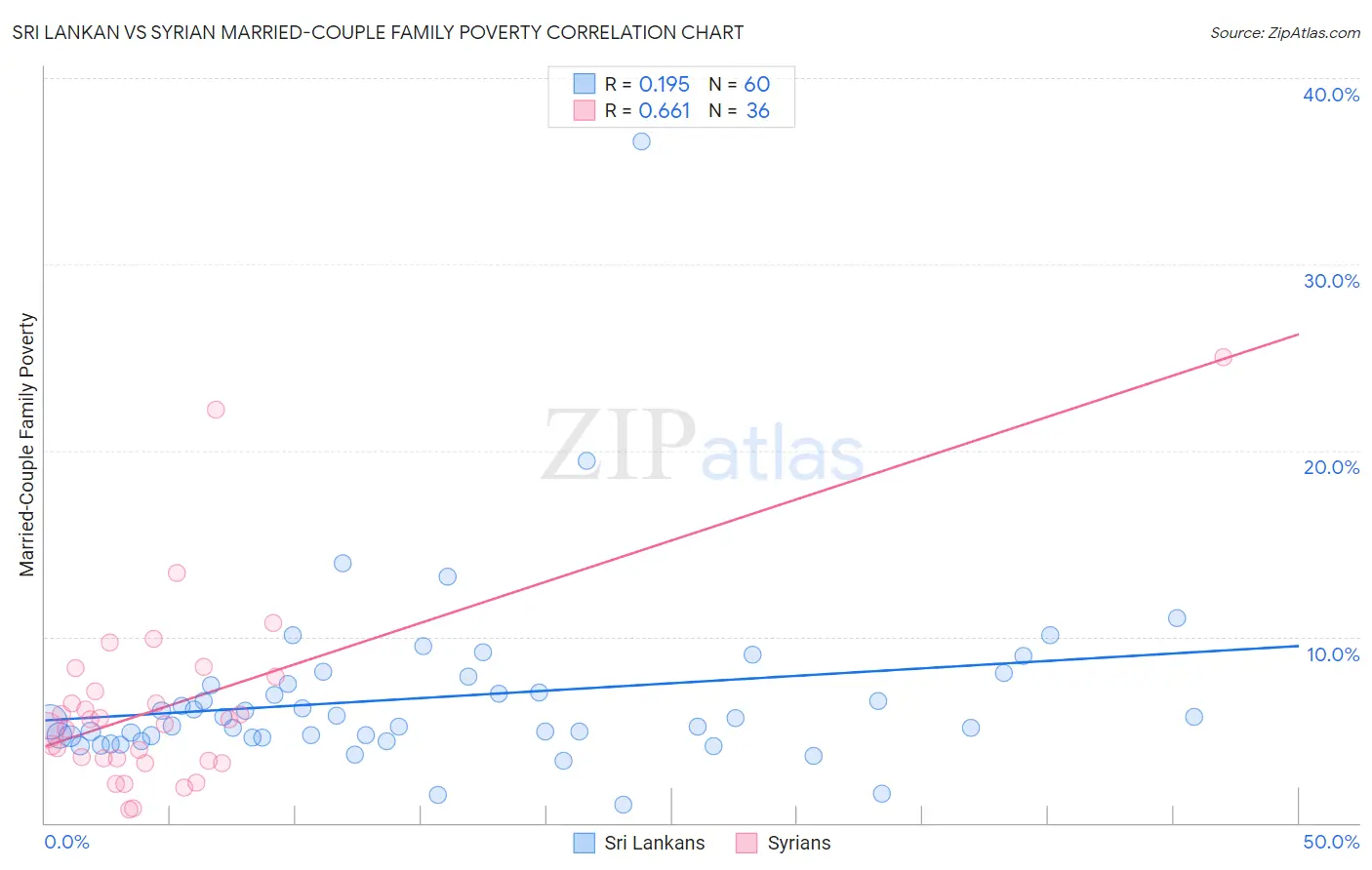Sri Lankan vs Syrian Married-Couple Family Poverty
COMPARE
Sri Lankan
Syrian
Married-Couple Family Poverty
Married-Couple Family Poverty Comparison
Sri Lankans
Syrians
5.1%
MARRIED-COUPLE FAMILY POVERTY
72.2/ 100
METRIC RATING
156th/ 347
METRIC RANK
5.0%
MARRIED-COUPLE FAMILY POVERTY
78.7/ 100
METRIC RATING
147th/ 347
METRIC RANK
Sri Lankan vs Syrian Married-Couple Family Poverty Correlation Chart
The statistical analysis conducted on geographies consisting of 436,204,277 people shows a poor positive correlation between the proportion of Sri Lankans and poverty level among married-couple families in the United States with a correlation coefficient (R) of 0.195 and weighted average of 5.1%. Similarly, the statistical analysis conducted on geographies consisting of 264,506,775 people shows a significant positive correlation between the proportion of Syrians and poverty level among married-couple families in the United States with a correlation coefficient (R) of 0.661 and weighted average of 5.0%, a difference of 1.1%.

Married-Couple Family Poverty Correlation Summary
| Measurement | Sri Lankan | Syrian |
| Minimum | 0.96% | 0.72% |
| Maximum | 36.6% | 25.0% |
| Range | 35.6% | 24.3% |
| Mean | 6.8% | 6.3% |
| Median | 5.5% | 5.4% |
| Interquartile 25% (IQ1) | 4.6% | 3.4% |
| Interquartile 75% (IQ3) | 7.4% | 7.5% |
| Interquartile Range (IQR) | 2.8% | 4.1% |
| Standard Deviation (Sample) | 4.9% | 5.1% |
| Standard Deviation (Population) | 4.9% | 5.0% |
Demographics Similar to Sri Lankans and Syrians by Married-Couple Family Poverty
In terms of married-couple family poverty, the demographic groups most similar to Sri Lankans are Immigrants from Ethiopia (5.1%, a difference of 0.040%), Argentinean (5.1%, a difference of 0.22%), Delaware (5.1%, a difference of 0.23%), Immigrants from South Eastern Asia (5.1%, a difference of 0.27%), and Immigrants from Saudi Arabia (5.1%, a difference of 0.27%). Similarly, the demographic groups most similar to Syrians are Immigrants from Russia (5.0%, a difference of 0.0%), Immigrants from Oceania (5.0%, a difference of 0.030%), Brazilian (5.0%, a difference of 0.080%), Mongolian (5.0%, a difference of 0.19%), and Immigrants from Spain (5.0%, a difference of 0.21%).
| Demographics | Rating | Rank | Married-Couple Family Poverty |
| Immigrants | Brazil | 84.6 /100 | #141 | Excellent 5.0% |
| Immigrants | China | 84.6 /100 | #142 | Excellent 5.0% |
| Immigrants | Egypt | 83.4 /100 | #143 | Excellent 5.0% |
| Hmong | 83.2 /100 | #144 | Excellent 5.0% |
| Immigrants | Spain | 79.9 /100 | #145 | Good 5.0% |
| Mongolians | 79.8 /100 | #146 | Good 5.0% |
| Syrians | 78.7 /100 | #147 | Good 5.0% |
| Immigrants | Russia | 78.7 /100 | #148 | Good 5.0% |
| Immigrants | Oceania | 78.6 /100 | #149 | Good 5.0% |
| Brazilians | 78.3 /100 | #150 | Good 5.0% |
| Immigrants | Cameroon | 77.3 /100 | #151 | Good 5.0% |
| Albanians | 77.2 /100 | #152 | Good 5.0% |
| Immigrants | Kuwait | 76.3 /100 | #153 | Good 5.0% |
| Delaware | 73.7 /100 | #154 | Good 5.1% |
| Immigrants | Ethiopia | 72.4 /100 | #155 | Good 5.1% |
| Sri Lankans | 72.2 /100 | #156 | Good 5.1% |
| Argentineans | 70.7 /100 | #157 | Good 5.1% |
| Immigrants | South Eastern Asia | 70.4 /100 | #158 | Good 5.1% |
| Immigrants | Saudi Arabia | 70.3 /100 | #159 | Good 5.1% |
| Pennsylvania Germans | 68.5 /100 | #160 | Good 5.1% |
| Ethiopians | 68.1 /100 | #161 | Good 5.1% |